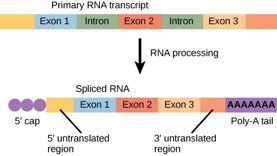44 Eukaryotic RNA Processing
Eukaryotic mRNAs must undergo several processing steps before they can be transferred from the nucleus to the cytoplasm and translated into a protein. The additional steps involved in eukaryotic mRNA maturation create a molecule that is much more stable than a prokaryotic mRNA. Eukaryotic mRNAs typically last for several hours, whereas the typical prokaryotic mRNA lasts no more than five seconds.
The mRNA transcript is coated in RNA-stabilizing proteins to prevent it from degrading while it is processed and exported out of the nucleus.
A special nucleotide “cap” is added to one end of the growing transcript, which also helps prevent degradation and helps the cell recognize this molecule as an mRNA that should be translated.
Once transcription is complete, an enzyme adds a string of approximately 200 adenine residues to the end of the mRNA, called the poly-A tail. This modification further protects the pre-mRNA from degradation and signals to cellular factors that the transcript needs to be exported to the cytoplasm.
Eukaryotic genes are composed of protein-coding sequences called exons (ex-on signifies that they are expressed) and intervening sequences called introns (int-ron denotes their intervening role; you can also think of them as interrupting sequences). Introns are removed from the pre-mRNA during processing. Intron sequences in mRNA do not encode amino acids that become part of proteins. It is essential that all of a pre-mRNA’s introns be completely and precisely removed before protein synthesis so that the exons join together to code for the correct amino acids. If the process errs by even a single nucleotide, the sequence of the rejoined exons would be shifted, and the resulting protein would be nonfunctional. The process of removing introns and reconnecting exons is called splicing (Figure 5). Introns are removed and degraded while the pre-mRNA is still in the nucleus.

References
Unless otherwise noted, images on this page are licensed under CC-BY 4.0 by OpenStax.
OpenStax, Biology. OpenStax CNX. May 27, 2016 http://cnx.org/contents/s8Hh0oOc@9.10:TkuNUJis@3/Transcription

